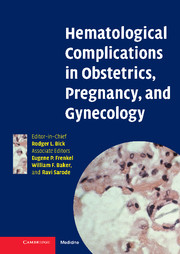Book contents
- Frontmatter
- Contents
- List of contributors
- Preface
- 1 Disseminated intravascular coagulation in obstetrics, pregnancy, and gynecology: Criteria for diagnosis and management
- 2 Recurrent miscarriage syndrome and infertility caused by blood coagulation protein/platelet defects
- 3 Von Willebrand disease and other bleeding disorders in obstetrics
- 4 Hemolytic disease of the fetus and newborn caused by ABO, Rhesus, and other blood group alloantibodies
- 5 Hereditary and acquired thrombophilia in pregnancy
- 6 Thromboprophylaxis and treatment of thrombosis in pregnancy
- 7 Diagnosis of deep vein thrombosis and pulmonary embolism in pregnancy
- 8 Hemorrhagic and thrombotic lesions of the placenta
- 9 Iron deficiency, folate, and vitamin B12 deficiency in pregnancy, obstetrics, and gynecology
- 10 Thrombosis prophylaxis and risk factors for thrombosis in gynecologic oncology
- 11 Low molecular weight heparins in pregnancy
- 12 Post partum hemorrhage: Prevention, diagnosis, and management
- 13 Hemoglobinopathies in pregnancy
- 14 Genetic counseling and prenatal diagnosis
- 15 Thrombocytopenia in pregnancy
- 16 Neonatal immune thrombocytopenias
- 17 The rational use of blood and its components in obstetrical and gynecological bleeding complications
- 18 Heparin-induced thrombocytopenia in pregnancy
- 19 Coagulation defects as a cause for menstrual disorders
- Index
- Plate section
- References
12 - Post partum hemorrhage: Prevention, diagnosis, and management
Published online by Cambridge University Press: 01 February 2010
- Frontmatter
- Contents
- List of contributors
- Preface
- 1 Disseminated intravascular coagulation in obstetrics, pregnancy, and gynecology: Criteria for diagnosis and management
- 2 Recurrent miscarriage syndrome and infertility caused by blood coagulation protein/platelet defects
- 3 Von Willebrand disease and other bleeding disorders in obstetrics
- 4 Hemolytic disease of the fetus and newborn caused by ABO, Rhesus, and other blood group alloantibodies
- 5 Hereditary and acquired thrombophilia in pregnancy
- 6 Thromboprophylaxis and treatment of thrombosis in pregnancy
- 7 Diagnosis of deep vein thrombosis and pulmonary embolism in pregnancy
- 8 Hemorrhagic and thrombotic lesions of the placenta
- 9 Iron deficiency, folate, and vitamin B12 deficiency in pregnancy, obstetrics, and gynecology
- 10 Thrombosis prophylaxis and risk factors for thrombosis in gynecologic oncology
- 11 Low molecular weight heparins in pregnancy
- 12 Post partum hemorrhage: Prevention, diagnosis, and management
- 13 Hemoglobinopathies in pregnancy
- 14 Genetic counseling and prenatal diagnosis
- 15 Thrombocytopenia in pregnancy
- 16 Neonatal immune thrombocytopenias
- 17 The rational use of blood and its components in obstetrical and gynecological bleeding complications
- 18 Heparin-induced thrombocytopenia in pregnancy
- 19 Coagulation defects as a cause for menstrual disorders
- Index
- Plate section
- References
Summary
Introduction
Although childbirth is a wonderful and enjoyable experience by most, it still is an anatomically traumatic event, associated with tissue injury, vascular disruption and the potential for blood loss. All deliveries are accompanied by physiologic hemorrhage from the genital tract, and the abdominal soft tissue in cesarean section (Table 12.1). Post partum hemorrhage (PPH) is an obstetrical complication, which can transform a normal physiologic process of labor and delivery into a life-threatening emergency within minutes. A routine cesarean section can be complicated by massive hemorrhage. The healthy mother may quickly become a patient in the critical care unit, requiring all of the available skill and resources of physicians, nurses, the medical laboratory and the blood bank for survival. A thorough knowledge of the risk factors, preventive strategies, approach to diagnosis and management of PPH are required to properly care for women presenting for delivery. Once PPH is diagnosed, hospital facilities and/or referral centers, laboratories and blood banks must be readily available to provide the optimal chance for a successful outcome. The availability of blood replacement and modern critical care are major determinants of survival in women who develop post partum hemorrhagic shock. Mortality from PPH is strongly correlated with substandard care. Clearly, it is the problem of PPH that most vividly illustrates the difference, worldwide, between management of the puerperium in developed countries from that in underdeveloped countries.
- Type
- Chapter
- Information
- Publisher: Cambridge University PressPrint publication year: 2006



